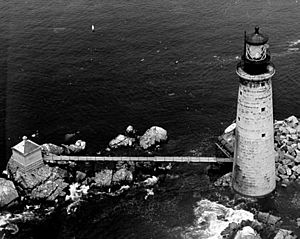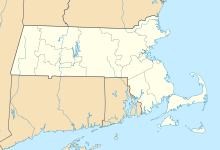The Graves Light facts for kids
 |
|
| US Coast Guard photo | |
|
|
|
| Location | Offshore of Boston, Massachusetts |
|---|---|
| Coordinates | 42°21′53.6″N 70°52′8.7″W / 42.364889°N 70.869083°W |
| Year first constructed | 1903 |
| Year first lit | 1905 |
| Automated | 1976, solar 2001 |
| Foundation | Granite |
| Construction | Granite Block |
| Tower shape | Conical |
| Markings / pattern | Natural with Black Lantern |
| Height | 113 feet (34 m) (tower) |
| Focal height | 96 feet (29 m) |
| Original lens | First order Fresnel Lens |
| Current lens | VRB-25 |
| Range | 15 nautical miles (28 km; 17 mi) |
| Characteristic | |
| Fog signal | HORN: 2 every 20s |
| USCG number | 1-390 |
The Graves Light is a famous lighthouse located near Boston, Massachusetts. It stands on a group of rocks called The Graves. These rocks are the farthest islands in the Boston Harbor Islands National Recreation Area. The lighthouse is about 9 miles (14.5 km) away from downtown Boston.
This lighthouse is very important for ships. It helps them find their way into and out of the Port of Boston. At 113 feet (34 meters) tall, it is the highest lighthouse in the area. It was built when a new, deeper path for large ships was made into Boston Harbor. The Graves rocks are right at the end of this path.
The Graves Light Station was added to the National Register of Historic Places on September 28, 1987. This means it is a special historical place in the United States.
Contents
Building the Lighthouse
The Graves Light was finished in 1905. It was built using strong granite blocks on a solid granite base. Its shape is like a cone, getting narrower at the top.
The Amazing Lens
When it was first built, the lighthouse had a special lens called a first-order Fresnel lens. This type of lens is very powerful. It was one of only a few such lenses used at the time. The lens assembly was about 12 feet (4 meters) tall! Today, this original lens is kept at the Smithsonian Institution museum.
How the Light Works Today
The United States Coast Guard operates the lighthouse. In 1976, the light became automated, meaning it works by itself. Since 2001, it uses solar panels for power. The light flashes white two times every 12 seconds. This unique pattern helps ships know it's the Graves Light.
Who Were the Graves?
The rocks where the lighthouse stands are named after someone called Thomas Graves. There are two main ideas about who he was. Some people think he was a rear admiral from England in the 1600s. Others believe he was an American merchant from the colonial times.
A historian found that the rocks were likely named after Rear Admiral Thomas Graves (1605–1653). His family settled in Charlestown, Massachusetts. However, he died in 1653 during a naval battle in England.
A Lighthouse for Sale
In 2013, the Graves Island Light Station was put up for auction. The starting price was $26,000. But people really wanted it! The winning bid was a record-breaking $933,888. This was the highest price ever paid for a lighthouse in the U.S.
A couple from Massachusetts, David and Lynn Waller, bought the lighthouse. It has two bedrooms, a kitchen, and a study inside. But getting to the lighthouse is tricky. You need to climb a 40-foot (12-meter) ladder to get into the building. A person who used to take care of the lighthouse said living there was like "living in a pipe."
Restoration and Future
As of 2014, the Wallers were working hard to fix up the lighthouse. This big project cost hundreds of thousands of dollars. The lighthouse is still used to guide ships today. It will continue to be a navigation aid because of the rules of its sale.
The lighthouse now gets its power from solar panels. Before that, it used to get electricity from an underwater cable connected to the town of Hull. Even earlier, it used an oil-fired lamp. The path to the building where the oil was stored washed away in 1991.


